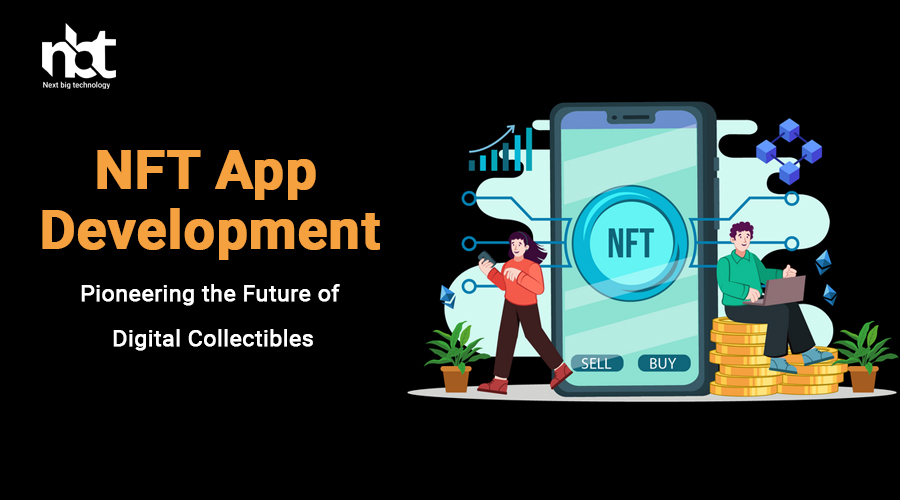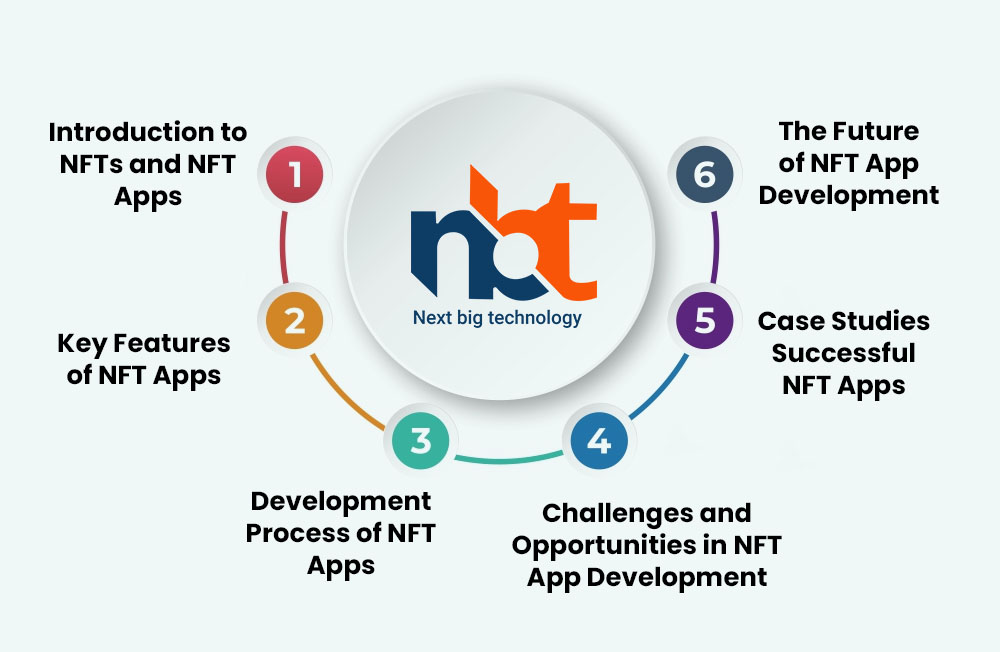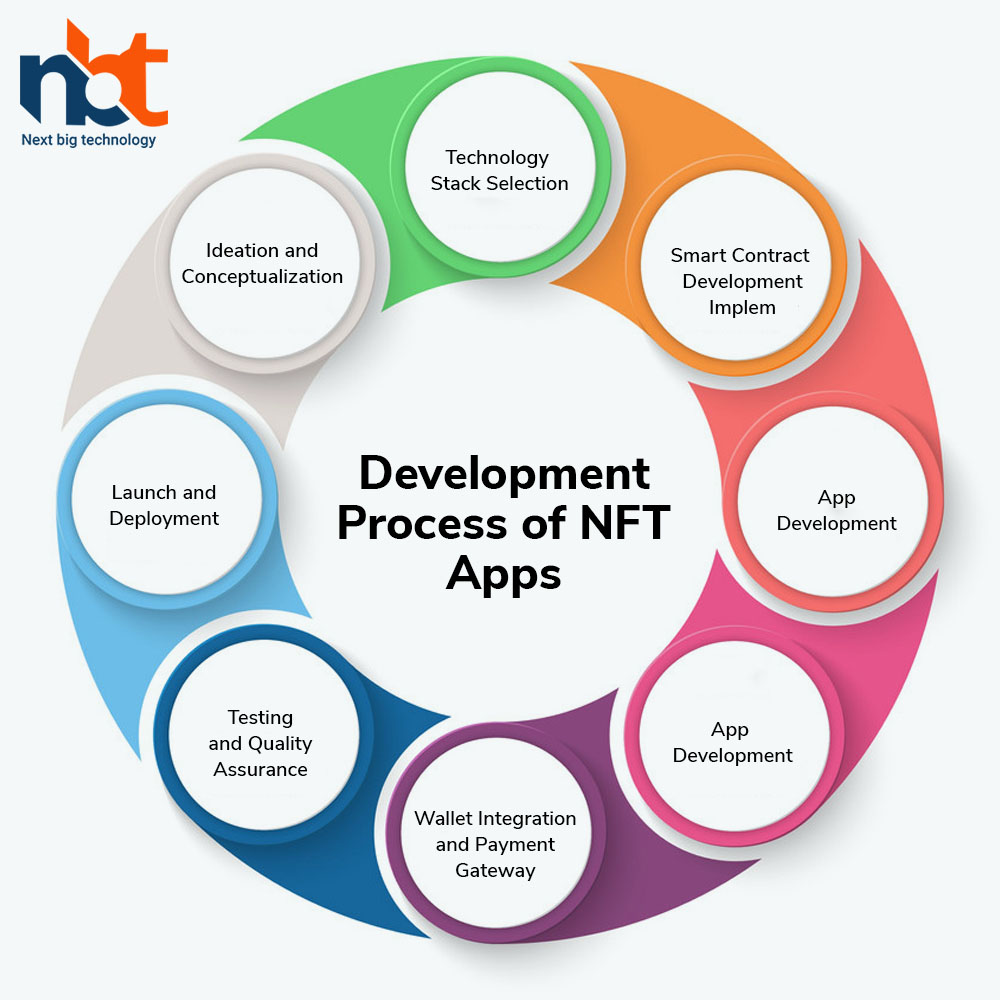In the ever-evolving landscape of digital technology, Non-Fungible Tokens (NFTs) have emerged as a groundbreaking concept, revolutionizing the way we perceive ownership of digital assets. As NFTs gain momentum across various industries, the development of NFT apps has become a focal point, offering users an interactive and immersive platform to engage with unique digital collectibles. This comprehensive guide delves into the intricacies of NFT app development, highlighting its significance, key features, development process, challenges, and the limitless opportunities it presents.
Table of Contents
Introduction to NFTs and NFT Apps
- Defining NFTs: Unlocking Digital Ownership
- The Rise of NFT Apps: Shaping the Digital Collectibles Space
Key Features of NFT Apps
- User-Friendly Onboarding and Authentication
- Seamless NFT Minting and Tokenization
- Interactive NFT Marketplace
- Personalized User Profiles and Dashboards
- Real-time Notifications and Alerts
- Secure Wallet Integration
- Social Sharing and Engagement Features
- Fractional Ownership and Investment Opportunities
Development Process of NFT Apps
Step 1: Ideation and Conceptualization
- Identifying Target Users and Niche
- Defining App Objectives and Features
- Wireframing and Prototyping
Step 2: Technology Stack Selection
- Choosing a Suitable Blockchain Platform (Ethereum, Binance Smart Chain, etc.)
- Smart Contracts Development and Deployment
- Backend and Frontend Technologies
Step 3: Smart Contract Development
- Implementing NFT Standards (ERC-721, ERC-1155)
- Token Minting and Metadata
- Ownership and Transfer Logic
- Auditing and Security Testing
Step 4: User Interface (UI) and User Experience (UX) Design
- Designing Intuitive and Engaging User Interfaces
- Crafting NFT Display and Exploration Elements
- Implementing Smooth Navigation and Interaction
Step 5: App Development
- Building NFT Listing and Marketplace Features
- Incorporating User Profiles and Portfolio Management
- Enabling Real-time Notifications and Alerts
Step 6: Wallet Integration and Payment Gateway
- Integrating Cryptocurrency Wallets
- Ensuring Secure Transactions and Payments
- Safeguarding User Private Keys
Step 7: Testing and Quality Assurance
- Rigorous Testing of Smart Contracts and App Functionality
- User Journey and Usability Testing
- Compatibility Checks across Devices and Platforms
Step 8: Launch and Deployment
- Deploying on Testnet for Final Testing
- Launching on Mainnet with Monitoring and Optimization
- Creating a Marketing Strategy for User Acquisition
Challenges and Opportunities in NFT App Development
- Scalability and Network Congestion
- User Education and Onboarding
- Regulatory and Legal Considerations
- Security and Privacy Concerns
- Environmental Sustainability of Blockchain Networks
Case Studies: Successful NFT Apps
- CryptoKitties: Cat-Themed Collectibles on the Blockchain
- Decentraland: Virtual Reality and NFT Ownership
- NBA Top Shot: Collecting Moments in Sports History
The Future of NFT App Development
- Integration with Augmented Reality (AR) and Virtual Reality (VR)
- Cross-Platform Compatibility and Interoperability
- Enhanced Gamification and Interactive Elements
- Integration with DeFi and Yield Farming
Conclusion
- Embracing the NFT App Revolution for Digital Collectibles
- Empowering Users to Own and Engage with Unique Digital Assets
Introduction to NFTs and NFT Apps
- Defining NFTs: Unlocking Digital Ownership NFTs are indivisible tokens that represent ownership of a unique item or piece of content on a blockchain. Unlike cryptocurrencies, NFTs are not interchangeable and carry distinct attributes that make them one-of-a-kind.
- The Rise of NFT Apps: Shaping the Digital Collectibles Space NFT apps provide an interface for users to explore, create, trade, and interact with NFTs. These apps bridge the gap between users and the blockchain, simplifying the process of minting NFTs, participating in auctions, and managing digital collections.
Key Features of NFT Apps
- User-Friendly Onboarding and Authentication Streamline user registration and login processes with secure authentication methods, simplifying the initial user experience.
- Seamless NFT Minting and Tokenization Enable users to easily mint their digital creations into NFTs by providing intuitive interfaces for uploading files, setting attributes, and generating metadata.
- Interactive NFT Marketplace Develop a marketplace where users can browse, discover, and purchase NFTs. Implement filters, sorting options, and categories for enhanced searchability.
- Personalized User Profiles and Dashboards Allow users to create profiles showcasing their NFT collections, purchase history, and preferences. Provide dashboard tools for portfolio management.
- Real-time Notifications and Alerts Implement push notifications to keep users informed about NFT auctions, bids, sales, and updates on their favorite artists or collections.
- Secure Wallet Integration Integrate cryptocurrency wallets compatible with the blockchain platform. Ensure secure key management and transactions within the app.
- Social Sharing and Engagement Features Foster community engagement by incorporating features like comments, likes, and shares. Facilitate interactions between creators and collectors.
- Fractional Ownership and Investment Opportunities Explore the concept of fractional ownership, allowing users to invest in high-value NFTs by purchasing fractions of tokens.
Development Process of NFT Apps
- Step 1: Ideation and Conceptualization Define the app’s target audience, objectives, and unique value proposition. Create wireframes and prototypes to visualize the user interface.
- Step 2: Technology Stack Selection Choose a blockchain platform that supports NFTs (Ethereum, Binance Smart Chain). Select backend and frontend technologies for robust app development.
- Step 3: Smart Contract Development Develop and deploy smart contracts adhering to NFT standards like ERC-721 or ERC-1155. Ensure token minting, ownership transfer, and royalty mechanisms.
- Step 4: User Interface (UI) and User Experience (UX) Design Design intuitive interfaces that enhance user engagement. Focus on ease of navigation, seamless browsing, and interactive elements.
- Step 5: App Development Build frontend components such as NFT marketplaces, user profiles, and real-time notification systems. Integrate with smart contracts for transaction handling.
- Step 6: Wallet Integration and Payment Gateway Integrate cryptocurrency wallets compatible with the blockchain. Implement secure payment gateways for purchasing NFTs.
- Step 7: Testing and Quality Assurance Test smart contracts for security and functionality. Conduct thorough app testing, including user journey testing and cross-device compatibility checks.
- Step 8: Launch and Deployment Launch the app on a testnet for final testing. Deploy on the mainnet with continuous monitoring, bug fixing, and performance optimization.
Challenges and Opportunities in NFT App Development
- Scalability and Network Congestion Address scalability concerns due to network congestion and high gas fees, potentially through layer-2 solutions.
- User Education and Onboarding Educate users about NFTs, wallets, and blockchain technology to ensure a smooth onboarding process.
- Regulatory and Legal Considerations Navigate legal aspects related to copyright, intellectual property rights, and the regulatory landscape for NFTs.
- Security and Privacy Concerns Implement robust security measures to protect user data, private keys, and NFT ownership rights.
- Environmental Sustainability of Blockchain Networks Explore eco-friendly blockchain alternatives to mitigate concerns about the energy consumption of NFT platforms.
Case Studies: Successful NFT Apps
- CryptoKitties: Cat-Themed Collectibles on the Blockchain CryptoKitties popularized NFTs, allowing users to collect, breed, and trade unique virtual cats.
- Decentraland: Virtual Reality and NFT Ownership Decentraland blends NFT ownership with virtual reality, enabling users to own and build on virtual land.
- NBA Top Shot: Collecting Moments in Sports History NBA Top Shot offers NFT-based highlights of iconic sports moments, engaging fans in a new way.
The Future of NFT App Development
- Integration with Augmented Reality (AR) and Virtual Reality (VR) Enhance user experiences by integrating NFTs with AR and VR technologies for immersive interactions.
- Cross-Platform Compatibility and Interoperability Explore solutions to enable users to access and trade NFTs across various platforms and ecosystems.
- Enhanced Gamification and Interactive Elements Integrate gamified elements to make NFT engagement more interactive and entertaining.
- Integration with DeFi and Yield Farming Combine NFTs with decentralized finance (DeFi) mechanisms, allowing users to earn rewards through yield farming.
Conclusion
The development of NFT apps marks a transformative era in digital collectibles, offering users unparalleled opportunities to own, trade, and interact with unique digital assets. By understanding the development process, challenges, and prospects within the NFT ecosystem, app developers and entrepreneurs can spearhead the creation of platforms that redefine digital ownership. As NFTs continue to reshape the digital landscape, NFT apps stand as pioneering tools that empower users to participate in the future of collectibles and digital ownership.



















